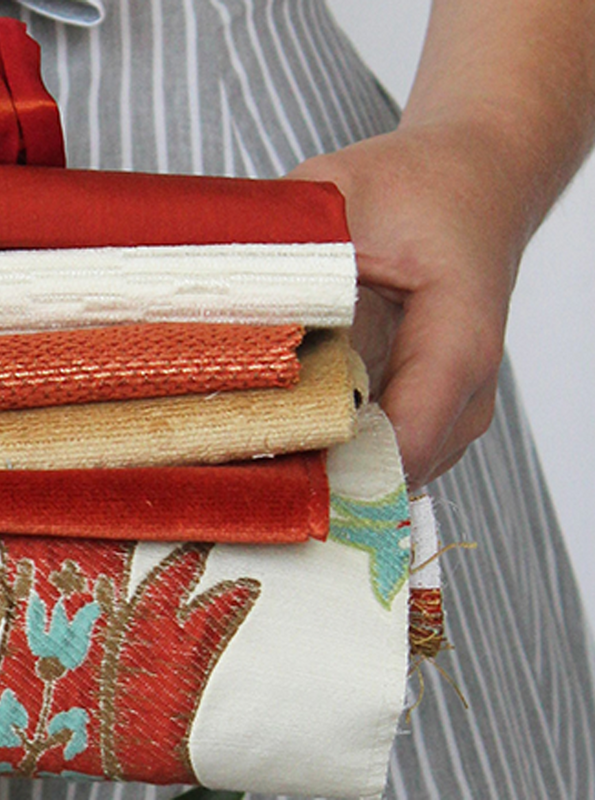Understanding The Undergarments of Window Dressing; Its all in the Lining and the Bump
Understanding Window Treatment Basics: Lining vs Blackout, Interlining vs Bump
When it comes to selecting window treatments, the second most important aspect, other than the primary fabric, is the perfect lining application. But first, the most important aspect is the primary fabric, which is the showcase of the window and most times the room. Therefore, it is vital that the primary drapery fabric has all the correct lining “the undergarments” required to perform functionally and aesthetically to your home needs.
A primary fabric should be something you love or something that compliments what you love i.e. pillow fabric. It should be timeless modern or timeless traditional but also provide versatility for years later when you’d like to redecorate this room. This creates opportunities to be flexible. The primary dressings for your window can be basically any fiber; silk, cotton, linen, polyester, wool, cashmere etc. This fabric can be sheer, satin, or velvet for example. Sheers typically do not require any lining; they’re intended filter the light. All other fabrics require different linings “undergarments”.
The primary fabric typically falls into two categories: Light Weight i.e. silks and fine fabrics or Bulk i.e., velvets, woven fabrics, basically anything that has some weight to it. Both make beautiful window dressings. The heavier the fabric the less undergarments are required because this fabric will drape well without. While lighter fabrics may require interlining and weights sewn into the hem to give the full luxurious drape they also deserve.
Among the various options, lining, blackout, interlining and bump each offer unique benefits and characteristics. Let’s dive into what each of these options entails and how they can impact your window treatments.
Lining: Protection and Functionality
What is Lining?
Lining refers to an additional layer of fabric sewn into the back of curtains or draperies. This layer serves multiple purposes, enhancing the performance of your window treatments. Lining protects your primary fabric from harsh temperature changes, moisture and sun damage, reducing fading and prolongs the primary fabrics life. It also filters light, making your home more energy efficient by insulating the room. Lining aids in noise control and provides a source of noise absorption. Aesthetically, lining provides a more polished look, offering a neater finish that enhances the overall aesthetic. Most importantly, lining creates continuity from the exterior of your home.
Types of Lining (exterior layer that faces the window)
- White or Ivory Lining: Commonly used, it provides basic light blocking and protection. Your workroom will typically choose the correct color that complements the primary fabric best.
- Blackout Lining: Interestingly, Blackout lining does not mean the lining is the color black. It is white but basically has an applied painted finish that seals the fabric lining and prevents any light from penetrating. Black out lining offers maximum light control and privacy, ideal for those needing a dark environment, such as a bedroom and media room. It is heavier in weight than regular lining.
Interlining vs Bump: (“The Luxury Layer” that is in the middle of the primary fabric and the lining)
What is Interlining?
Interlining is soft fiber felt pad, typically cotton that creates the padded layer of fiber placed between the primary fabric and the lining. This additional layer elevates the quality and performance of window treatments. It gives the primary fabric its luxurious fell and appearance “bringing it to life” when required, especially with thinner primary fabrics. The interlining comes in different thicknesses and weights, with the max weight/thickness being referred to as “Bump”. Bump is usually reserved for fine silks because it adds the most weight and body needed.
Benefits of Interlining
- Enhanced Insulation: This layer offers superior insulation, making it one of the best choices for energy efficiency.
- Improved Soundproofing: Interlining can further reduce noise, ideal for urban settings or homes near busy roads.
- Luxurious Appearance: The added bulk gives curtain a more sumptuous look, making them appear more opulent and well-crafted. Light can still be seen through the interlining, allowing the primary fabric’s beauty to be enhanced, especially at sunrise and dusk.
- Shape Retention: Curtains with interlining hold their shape better, ensuring a tailored appearance that lasts.
Making the Right Choice
When deciding between lining vs blackout and interlining vs bump, consider that bedrooms and media rooms benefit most from blackout lining and this is the spaces it is most reserved for use. But as an alternative and added cost, added interlining in a bedroom may create enough darkness and it is not only beautiful, but ever so elegant to see your fabric enhanced by the different times of day. Lining with interlining still allows the natural light to highlight the beauty in the primary fabric while blackout does exactly that - it blocks all light and makes your space light night. Your fabric will only be visible when it is lit from within space. If you want your child to get up with the sun, we suggest using lining (and interlining only if needed). Interlining is more expensive and typically reserved for the master, guest and living spaces within the home, but it really come down to which fabric you fall in love with and how to best address your needs and the fabrics. You may have the workroom show you samples of all these and hold up to a window to visually see the difference with your primary fabric.
Conclusion
Selecting the right fabric for your window treatments is essential for achieving both style and functionality. Whether you opt for full blackout lining to enhance protection and light control, bulk or weights for luxurious drapery, or interlining bump for a sumptuous feel, understanding these options will help you create the perfect ambiance in your home. Happy decorating! We’re here to help you if you have any questions, please email us service@focalfabrics.com



